Search: Running Lines At Depth Fixing Defenders
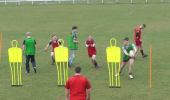 6:32
6:32
Fixing Defenders
Starting with a simple 3 man passing drill the coach adds pressure adding fixed defenders and then live defenders, the progressions are intended to be game related. Ask questions to confirm technical points
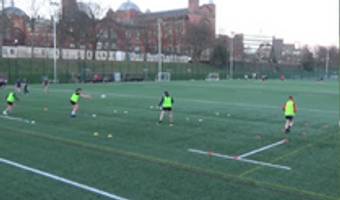 1:26
1:26
Running & Passing Lines
The aim is to fix defenders via the attacking players running straight, and preserving the space on the outside and to stop defenders from drifting. This will support the executing of overlaps.
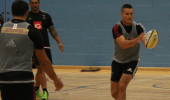 3:05
3:05
Quins - Tips On Fixing Defenders
The best players and the best teams can all run straight and fix defenders. For some it is the most important technique to master. This clip features three different practises
To watch over 2500+ videos join now for free!
JOIN NOW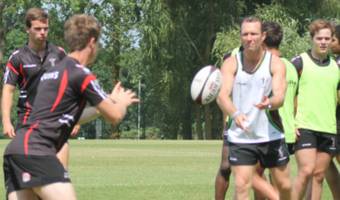 3:05
3:05
3 v 2 How to Fix Defenders
Running straight & fixing defenders is a skill that all players must learn and learn at an early age. The top players regularly practise this skill to maintain accuracy. This is the building block to scoring tries
 3:22
3:22
Stay square & fix defenders
Create space by fixing defenders. This is one of the toughest skills to learn and in this clip Colin Osbourne from Harlequins explains some of the challenges coaches face and how to "Stay square"
 2:40
2:40
Falcon's Grid exercise for running lines
Running straight and changing your running line will make players better attackers and underpins an effective 2 v 1. Dave Walder from Newcastle Falcon's run's through a new style exercise that all coaches can use.
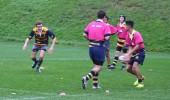 1:47
1:47
Running Lines in Attack
Modern defensive lines are well-organised and hard to break. It depends on the quality execution of attacking fundamentals. A good introduction is 'unders' and 'overs' running lines. Log in to see the full session.
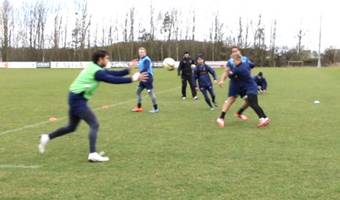 2:43
2:43
Improve Running Lines
Use this simple drill from Newcastle Falcons to improve your player's running lines.
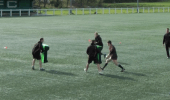 4:04
4:04
Developing running lines to attack
A series of progressions to develop how players attack when "Coming round the corner" from phase play
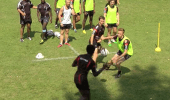 5:59
5:59
Quins - Creating Space & attacking lines
This clip shows the principles of fixing defenders and the techniques used to do so. The coach can progress by using more defenders, varying the space or changing the source of where the ball comes from
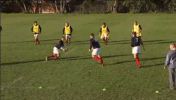 0:39
0:39
Supporting lines - Trail running
A game to challenge how players support with lines of running and communication
Back Play from Set Piece - Attack from Line Out
To take advantage of the forwards being grouped and to utilize the space this provides, the appropriate strike call needs to be made and space attached.
Attacking the space between the two teams is paramount and attacking the ball when running support lines will assist the offload and turn defenders.
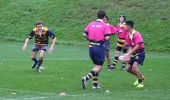 4:18
4:18
Attacking Lines: Unders and Overs
Using different angles of running confuses tacklers and pulls a defensive unit out of line. Learning the skills to both run these lines and pass the ball accurately is key to any ambitious team looking to attack and offload
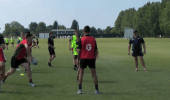 6:36
6:36
Attacking lines and late shifting
This clip demonstrates the skills and movements required to fix and beat defenders. Using a combination of passing accuracy and physical agility can significantly improve your attacking options. The coach uses questions to help the players learn
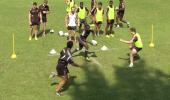 6:17
6:17
Quins - Attacking lines of support
Harlequins academy players are coached to be accurate in their passing and use lines of running and footwork to create space for other players
L2 - Fly Half Development
Skill Practice Description • Two channels each 15metres wide • Two attacking lines of four players; one line in each channel • Scrum Half with two balls • Three defenders lined up to defend the designated channel. • SH passes ball to 1st attacking group on the coach’s call. • D1 goes for A1, D2 for A2, D3 for A3 • Attackers to fix defenders and release overlap. • Coach shouts “Break” and the three defenders run to defend the other channel against 2nd group of attackers. • On coach’s command “Go” the 2nd ball is passed to the second line • Rotate the groups and alternate which channel has the first strike / second strike • Vary the timing of the second call which releases the ball for the 2nd strike. An early call frees up space for the fly half because the defenders will have little time to get into the second channel. A late call, allows defenders time to get across, and it means the fly half will have to prevent the drift and effectively use the overlap. • Initially the coach can control the defence telling the defenders to leave the overlap and be fixed; then allow them to drift, then allow them to try anything to stop the attack. Here is also an opportunity to coach how to defend. Key Coaching Points • Stay square - outside shoulder should be seen by scrum half • Run at defenders aiming at the inside shoulder • Move when the ball is in the scrum half’s hands or when it is in the air. Do not creep forward before then.
L2 - Back Line Attack from Set Piece
Skill Practice Description • The objective of this game is to score from first phase. • The defence start on the try line and can only advance to the five metre line (gain line). • The attack must start from the 5 metre line if simulating a scrum and vary the starting points i.e. centre field. • If simulating a lineout start, use the 10 metre line to half way. • If the attack can score from the set piece they are awarded five points. • If they score after one phase they are awarded four points. • If they score after two phases they get awarded three points and so on. • If the attack fails to score after four phases they turn around and defend. • Kicking options may be introduced. • Five attacks each team. Key Coaching Points • Appropriate passing (short, long, flat, deep etc.) • Appropriate running lines; decoy / option / creating spaces / accelerating into space. • Support and reaction. • Look-Think -Do Process • Allow the players to self correct before intervention from the coach Relevance to the Game • Accuracy in decision making scanning and decoy / option running lines
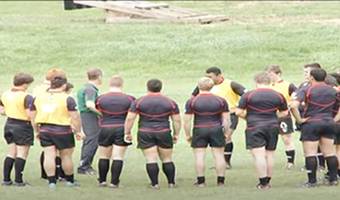 2:16
2:16
L2 - Outflanking Game
Skill Practice Description The objective of this game is to develop the ability to execute the 2 v 1 with consistent efficiency. • The attacking team initially has at least one extra players in order to create an advantage. • There is a channel on each wing in which only 1 defender and 2 attackers may enter at any time. • The attack works the play to get the ball into the outside channel then execute the 2 v 1. • With the extra players, the attack can also develop opportunities to penetrate the defence and so the game in not relying on lateral moment and still incorporates the principles of ‘go forward’. • The progression is to remove the cones and see if the players can still take advantage of the 2 v 1 without the conditions set within the channelled areas . • A further progression would be to even the numbers of each team. Key Coaching Points • Running lines to condense and hold defences in order to outflank. • Running lines in order to disrupt and penetrate the defence line. Relevance to the Game • Attacking players often fail to fix defenders effectively and may drift or over elaborate. • This game will assist in angles of run that fix the last defender
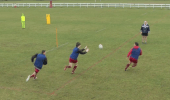 5:22
5:22
Passing Progressions with defenders
Use progressions to change the pressure points so that players are taken "Out of their comfort zone" and experience more match related situations. Rugby is about creating a 2 v 1 opportunity so fixing defenders is one of the most important skills to learn
Back Play - Attack From Line Out - Older Youth
To take advantage of the forwards being grouped and to utilize the space this provides, the appropriate strike call needs to be made and space attacked
It’s not a matter of going through the strike move repertoire. It is about specific selection from the repertoire in order to attack identified areas of the opposition and game situations
Attacking the space between the two teams is paramount and attacking the ball when running a support line will assist the offload and turn defenders
 2:46
2:46
L2 - Support Line Breaks & Offloads
Skill Practice Description • The game begins with touch tackles. • Once tackled the ball carrier is allowed to step beyond the tackle line and the support from either side run toward (or attack) the ball. • The pass must be delivered behind the tackle line and not put back in front of the defence, so speed and decision making is vitally important. • Develop the game to grip tackles below the rib cage so the ball can be off loaded. • Progress to full tackles and the ball carrier must fight to keep the ball available. • The support must be aggressive in attacking the ball and getting between and beyond defenders. • When in full contact and the ball carrier cannot off load immediately, rucks and mauls may be played. Key Coaching Points • The game relies on good support play in all areas. This game illustrates the need for consistent and aggressive support. • The supporting players need to work for the ball carrier and attack the ball, getting in behind the defence for an off load. • Once the tackle line has been breached the attack must not allow the defence time to reorganise. • When progressed to full contact, the demand on decision making increases
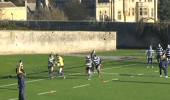 0:58
0:58
Offload behind Defender
A very useful skill if you are looking to break the gain line. The running lines and the communication from the support players are essential. This drill aims to develop the mechanics of the offload through repetition.
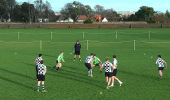 6:02
6:02
Game to coach Depth
Ex England Sevens coach Russell Earnshaw talks through the importance of depth and keeping "Connected". He uses a simple exercise to work on various techniques and makes it competitive to keep the intensity high
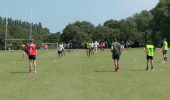 6:00
6:00
Passing and Support Lines
This clip shows the classic passing process but with a significant twist in what players can do post the pass
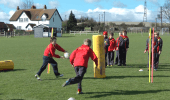 1:02
1:02
Passing - 2 v 1 Static Defender
Now working in just twos, we are concerned with depth, and the timing of the pass. Allow players to practice before adding a static defender. This can be a tackle bag as demonstrated. Players take the ball up to the defender but must complete the pass before they reach it.
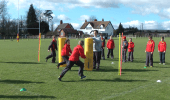 1:16
1:16
Passing - 3 v 2 Static Defenders
Progress to working in 3s against two static defenders. The pressure is on the middle player to hold their depth and perform a quick pass.
Back Play - Attack From Scrum - Older Youth
It’s not a matter of going through a strike move repertoire. It is more about specific selection from the repertoire in order to attack identified targets according to the opposition and game situation
Attacking the space between the two teams is paramount and attacking the ball when running a support line will assist the offload and turn defenders
Back Play from Set Piece - Attack from Scrum
It’s not a matter of going through the strike move repertoire. It is about selecting appropriately from the repertoire according to the opposition and game situation.
Attacking the space between the two teams is paramount and attacking the ball when running support lines will assist the offload and turn defenders.
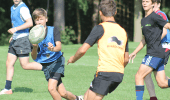 3:57
3:57
More Time on the Ball
Good players have more time on the ball? What they do do is prepare accurately with depth, width and run good lines. This sets them up to catch & pass with time and options. The practises in this clip outline some of the disciplines required to get you "More time"
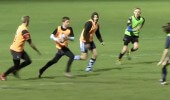 5:23
5:23
Passing and Attacking Lines
Northampton Saints Academy coaches introduce a conditioned exercise to help develop attacking skills.
L2 - Support Line Breaks
Skill Practice Description • The objective is to increase the commitment to supporting a line break. • The teams play continuous touch, grip or tackle. • Stage 1: when a score is made all attacking players must touch the try line within 3 seconds or the try is disallowed and a turn over is awarded. • Stage 2: when a try is scored all attacking players must touch the ball on the ground within 5 seconds or the try is disallowed and a turnover is awarded. • Play starts again direct from the try line. • The coach may split the defence so cover defenders can challenge the effect of support play once the first line has been breached. Key Coaching Points • Encourage supporting players to angle toward the line break and not stay wide and lateral. • Encourage all attacking players to react and support a line break. • Speed of reaction. • Communication and team work
L2 - Penetrating Defence Game
Skill Practice Description • The playing area is marked out in 5m channels. • When defending, players must stay within their channel throughout the game. • The attack must look to penetrate the defence by creating and preserving space. • The defence must use a two handed touch. • There is a 5 tackle turnover rule and once possession is turned over, the defence must get into a channel as the opposition can attack immediately. Key Coaching Points • Support players to hold their opposite number as long as possible before cutting a line to take the pass. • The defender can close the space as far as the edge of their own channel. • If the support player cuts too early or the ball carrier does not move their defender enough, the support player will be touched/tackled. Relevance to the Game • This game will help develop the footwork and running lines to effectively move defenders in order to penetrate the tackle line.
 4:08
4:08
Stop Your Players Crabbing Sideways
Successful rugby requires players to run straight and fix defenders. This is a constant challenge to coaches and new ideas and exercises can freshen up your training sessions, this clip has two practises along with some advice from elite coaches
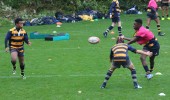 6:03
6:03
Timing the Pass
This exercise looks to develop the decision-making around the timing of a pass, and highlights running at pace and holding depth.
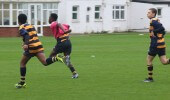 7:01
7:01
Drop off touch - start with a game
Chris Kibble of Esher RFC & Whitgift school says to start your sessions with a game. In this clip Chris runs a game called "Drop touch" where the players run back to a line when they make a touch. This is good for fitness and creating wholes to attack
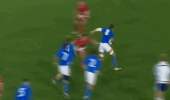 0:40
0:40
IRB Men's - Offloads 3
A quick lineout allows players to attack a "broken field" defence. Running at space moves the defenders and the suport player comes from depth behind the attacker to score. Key factors : Loud communication - Accurate spin pass - Attacking space - Trail support - Pop pass - Quick running
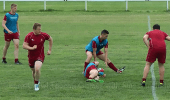 4:49
4:49
Bear Crawl Touch
During pre-season, it's a great idea to keep training fun, but with emphasis on building fitness. Conditioned games are an excellent way to do this. In this game, defenders who make a touch must run back to their own try line and complete a bear crawl before rejoining the game. This gives opportunities to the attacking team.
L2 - Attacking a Drift, Blitz and Cover Defence
Skill Practice Description • Within a game of touch the coach can at any breakdown - call blitz, drift and the defenders must run and touch the appropriate line. • The coach may also give players numbers in order to call specific defenders to leave the defence line which will create the need for defence to realign quickly. • Attackers must face the other way and attack when the ball is rolled from behind them. • On the coach’s call, the attack turn and the closest attacker picks up the ball and plays. • This ensures the coach can vary each player’s role and make the defence react. • Coach can then develop game by giving a visual clue to the defenders thus making the attackers react to an unexpected type of defence. Key Coaching Points • Visual Acuity-Looking for space. • Spatial awareness. • Highlighting defensive systems and attacking them appropriately. • Decision making. Relevance to the Game • This game is excellent for visual acuity and attacking differing defensive alignments. • Spaces are created by the leaving defenders, which the attackers have to identify
L2 - Decision-making Development
Skill Practice Description • The coach kicks the ball out to the waiting attackers from under the posts. • The coach calls out a number of defenders to defend (4 in the example). • This number can change depending on ability. • The attacking team need to catch the ball and attempt to score on the try line without being touched (more than 1 touch can be allowed depending on ability) • Dropping the ball or being touched in possession results in a fail and all attackers must return to the 10m line before starting again. • The drill can be used as a competition by allowing each team a specified number of attempts before swapping the sides, the team scoring the most tries wins. Key Coaching Points • Being aware of the space between attack and defence • Using depth and not attacking in a flat line • The need to create 3v2’s and the ultimate goal of creating 2v1’s. Relevance to the Game • Attacking a broken field. • Collecting a lose kick and counter attacking with an assessment of the • opportunities presented. • Appropriate selection of pass i.e. long or short
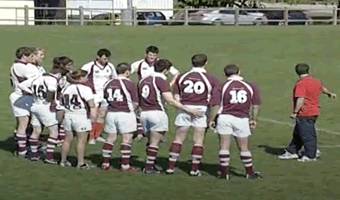 4:17
4:17
Defensive Line Game
Defensive Line Game
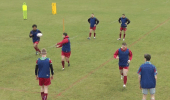 5:41
5:41
Catch & Pass Progressions
Passing progressions are based upon the ability of players to fix defenders. Always insure your exercises reflect match situations and refrain from just doing drills because they look good
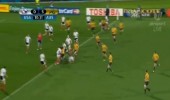 0:17
0:17
Men's - 2 v 1
A good example of phase play to create a 2 v 1 attacking platform. The initial deep pass then creates an overlap and the defender drifts to allow the attacker to run through easily.
Key factors : Quick ball at breakdown - Straight lines of running - Deep pass - straight lines of running again - Loud communication
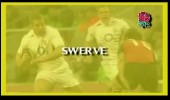 0:16
0:16
Running skills the swerve
Developing core skills
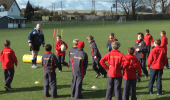 2:15
2:15
Passing - 3 v 2 Live Defenders
Gradually progress from 2 static defenders, to 3 v 2 roaming defenders. The first two players must draw their defenders before giving the pass.
 3:21
3:21
Three Channel Passing Challenge
Adding pressure to key skills is crucial to improve your players and to practise like you play. This exercise covers a variety of skills but essentially is about accurate passing and fixing defenders
L2 - Colours Touch
Skill Practice Description • Each player is given a colour. • The coach will call out a colour at any time during the game. • The defender/s who have been given that colour need to leave the defence line, run round the nearest cone of that colour and rejoin the defence. • The attack should identify where the spatial opportunity has appeared and take immediate advantage. • The frequency of the call depends on how much the coach wants to work the players. • The coach may call for all players, both defence and attack, to run around an allotted cone colour. • Coach should have two rugby balls to ensure a fast game and a change of defence to attack at times. Key Coaching Points • Visual Acuity-Looking for space • Spatial awareness • Communication - highlighting spaces and mismatches • Evasion skills and footwork • Decision making Relevance to the Game • Spaces are created by the leaving defenders, which the attack has to identify, decide on the appropriate action and attack accordingly. • By using the second ball, the coach can also develop counter attack
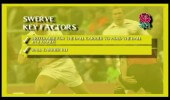 0:38
0:38
Running skills the swerve key points
Running skills coaching points
Back Play - Attack From Scrum - Younger Youth
To take advantage of the forwards being grouped and to utilize the space this provides, young players should be encouraged to develop their decision making from a non-prescriptive environment.
It’s not a matter of going through a strike move repertoire. Its a matter of attacking the space between the two teams and running support lines that will assist the ball carrier
Coaching 7-a-side Rugby - Side line press
In Defence:
Stay alert, keep on toes, specific communication, react, work hard
Defend what is happening – not what you think is going to happen
Trust the defence system, trust your team mates – trust yourself
L2 - Bozo Touch
Skill Practice Description • There are to be three teams. • Two teams play while one wait by the touch line. • When a score is made, the defence pick up the ball and attack immediately. • The scoring team leave the pitch while the waiting team run on and defend. • Turnover of possession is via a score, a forward pass, dropped ball, intercept etc. • The rules may also stipulate a six touch turnover for example. • The coach to observe how the waiting players spread when in the off pitch area in order to cover space when called onto the pitch. It may not be the team in possession at that time that scores. Key Coaching Points • Speed in scanning and communicating the spatial opportunity. • Development of foundation skills, passing and running. • Innovation in positioning when planning to enter the pitch from outside. • Develop team work and commitment to each other. Relevance to the Game • Develop the understanding of inviting multiple defenders into a tackle area in order to create space elsewhere.
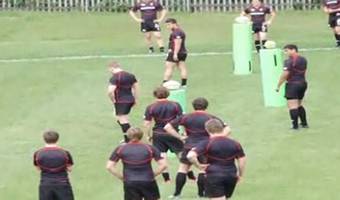 2:53
2:53
L2 - Conditioning Circuit
Using the full length of the pitch the practice is a continuous 3 v 2 scenario. • 3 attackers knock over a bag to collect a ball and attack 2 defenders in the 5m channel. • If they fail to beat the defenders (touch/grip), the attackers run back to knock over another bag and start again. • Having beaten the first defenders they carry on with the same ball to beat 2 further defenders who may choose a colour and start from the appropriate cone. • If the attackers fail to beat the defence they run back to the bag and start again with another ball. The defence can choose another colour to start from. • The next challenge is two free roaming defenders. If the attack fail they go back and knock over another bag to start again. • Finally the defenders choose a colour to start from and if the attack fail they get another ball and the defence choose another starting colour. • The objective is to complete the attack with the starting ball and restarts. Keep score to create competition
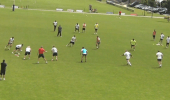 0:42
0:42
The Defensive Line
The Defensive Line
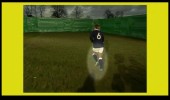 0:31
0:31
Running skills progression
Developing running skills
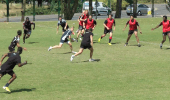 6:47
6:47
Quins - Beating a Drift Defence
Some warm up exercises with varied catch & pass skills in preparation to move onto fixing defenders and how to beat a drift defence
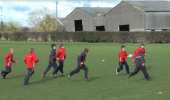 2:28
2:28
Conditioned Touch - Linked defenders
In this game, two defenders must link up, slowing them down and creating more opportunities for the attacking side. This can create the overlap necessary to put 2 v 1 and 3 v 2 techniques into practice.
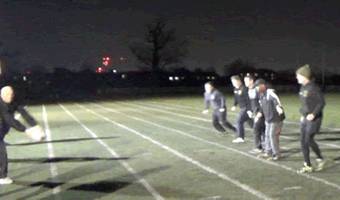 2:39
2:39
Line Speed Game
Use this great game to work on your team’s line speed and spacing. Reward the defence for moving the defence back and punish them for passive defence.
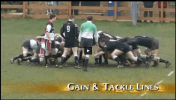 0:51
0:51
Game Understanding - Gain line & Tackle line
It is important that the players and the coach have a common understanding of where the gain line is, from a set piece and also from a ruck or maul. This is often not fully understood and may influence the success of both attack and defensive objectives. It is also important to understand where the tackle line might be, as this will impact on the strategy and alignment of the back line.
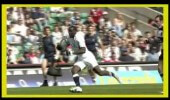 0:28
0:28
Running skills the swerve in action
Running skiils in a game
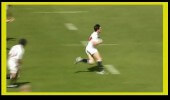 0:29
0:29
Running skills
core running skills in a game
L2 - Tactical Scoring Game
Skill Practice Description • Play 7v7 in the game area but mark different scoring zones along the try lines (use coloured cones). • Mark 5 metres in from each try line with red markers and if a try is scored in either of these areas then it will be worth 8pts. • The next two 5 metre zones moving inwards would be worth 5 pts and the rest of the try line worth 3pts. • This should challenge the ability to outflank or penetrate in order to build a score. • It may be that the defenders primarily defend in the outside channels leaving the middle with more space. • The attack can then take advantage of this new situation, scoring in the middle zone. • Thus identifying the weaknesses of the defence. Key Coaching Points • Spatial awareness • Communication • Quickness of attack at a disorganised defence • Skills to attack space • Footwork and evasion skills • Scanning skills • Decision making Relevance to the Game • This game challenges the decision making of both attack and defence. • If for example a turn over occurs, which score area does the attack target? • Which area does the defence cover and defend first?
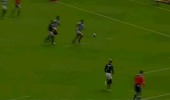
Sevens - 2 v 1
Seven's is about creating chances and then taking them. In this clip the Blue team take the ball up the middle of the pitch to draw in defenders, after recycling the ball they have a 2 v 1 opportunity, a straight line of running and a flat wide pass creates the try. Key factors : Call early - Run straight - Wide spin pass - Catch and swerve to score
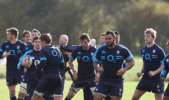 2:13
2:13
L2 - Drop-off Touch
Skill Practice Description • The teams play touch with the ball being passed back through the legs when touched. • The defender/s who make the touch, turn (drop off) immediately and run to their own try line. • These drop off defenders need to realign with the defence as soon as possible. • The attack should seek to take advantage of the space created by the drop off defender/s. • To get maximum effort from the players, it is advised the pitch is not so long that players do not make the effort to realign in defence. • The coach may observe the attacking players moving the ball away from the space opportunity left by the drop off player. It may be that the defence close the space left by the drop off, however this will create space elsewhere. Can the attack find the appropriate space to utilise? Key Coaching Points • Speed in scanning and communicating the spatial opportunity. • Defensive effort to drop off a realign so the defence can cover the primary threat.
L2 - Scatter Defence Game
Skill Practice Description • Ideal practice for when defences break up later in games or with counter attack decision making. • Attackers stand in front of a numbered cone and ball. • The coach calls a number and all attackers must run around their own numbered cone but whichever number was called, that ball becomes active. • At the same time a colour is called for the defenders and all defenders must turn and run around a cone of that colour. They must however choose different cones. • If a touch is made, the teams swap over roles. • If a try is scored, the attackers stay the same. • First to five tries wins. Key Coaching Points • Spatial awareness • Communication • Quickness of attack at a disorganised defence • Skills to attack space • Footwork and evasion skills • Scanning skills • Decision making • Importance of getting behind defenders Relevance to the Game • Great for coaching counter attacking disorganised defences from different angles. • Any player can be ball carrier and communication is vital as is decision making in identifying space and the best way to attack it successfully • Cones can be placed to shape different types of defence. Organised or scattered
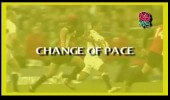 0:35
0:35
Beating defenders with speed
Changing speed is a skill which all players should understand
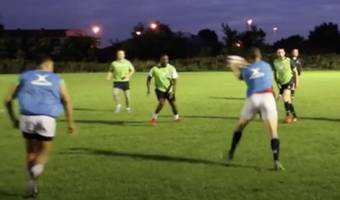 3:39
3:39
Two Touch With Tackle Practice
This game has multiple conditions for both attackers and defenders. Dropping defenders to practise their tackling while working on support lines and groundwork for the attackers. Great for the first half an hour of your session
QBE - Back Line Attack From Set Piece
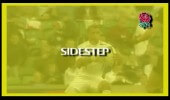 0:43
0:43
Running Skills the sidestep
The sidestep is a key fundamental movement in rugby. This clip outlines the foundations to this movement and is something that can be done at home in isolation or encourage in games and other practises
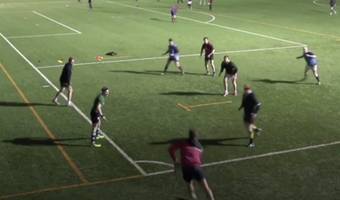 2:04
2:04
Quick Finishing Game
This quick game is perfect for developing the finishing in your team! Progress this drill with conditions to help improve depth and realignment.
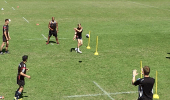 6:38
6:38
Practice Accurate passing
This clip reinforces the importance of passing and especially accurate passing. The coaches use a variety of practises to test the players skills and help them progress
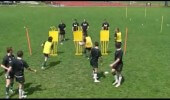 0:30
0:30
Pressure on the pass
Pulling the pass backwards allows the creation of depth from a flat line to be achieved and pace to be put onto the ball. coaches can use poles / Tackle bags or people as static defenders
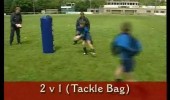
Learning to pass 2 v 1
Developing lines of running to attack the inside shoulder of defenders
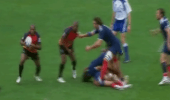 0:34
0:34
Sevens - Turnovers and move the ball 4
From a turnover in contact the attackers pass the ball wide one way and then a deep wide pass back in the other direction to pull the defence out of shape and create an opportunity to attack. Key factors : Wide flat pass - Players support from depth - Deep wide pass - Running and swerving past the defender
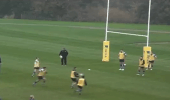 0:58
0:58
Passing in 4s - variations
Adding variations to a basic lateral passing drill is a solid foundation to build into strike moves. Players should concentrate on pass accuracy and the timing and direction of their running lines. Add defenders to progress.
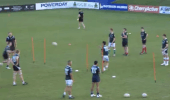 0:44
0:44
Learning to pass deep
Players must pass through gate before passing to supporting player before they reach the gate. This helps to ensure supporting players hold their depth and maintain a straight running line.
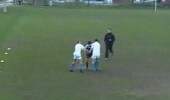 0:11
0:11
Ball retention wide
If a drift defence has you pointed towards the touch-line, the wide player should change their running direction and attack the inside defender. This is proactive and gives more chance for the ball to be recycled for another attempt.
Continuity in Attack - Diamond Practice
The diamond practice can be the break out session of a whole part whole approach.
It is common when running such a practice for the attacking players to arrive at the tackle line having caught each other up. Depth should be maintained in order for the diamond shape to be fully effective.
The initial ball carrier needs to use footwork to move and disrtupt the defensive shape
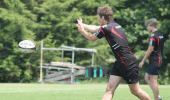 4:17
4:17
Attacking Ability at 13
Outside centres who have great attacking awareness and distribution skills are integral to teams who like to exploit quick ball by going wide. If these players are only able to run hard lines, then there are going to be missed opportunities out wide. Here, we highlight some great passing and attack play in the Premiership, as well as some ideas for you to use with your players.
L2 - Diamond Support Development
Skill Practice Description • Play a game of touch or grip tackle. • At the coach’s discretion, call “slow ball!” or “freeze” and allow the attack to form a diamond behind the 1st or 2nd receiver. Then call “Play!” • The defence will also be organised but this will be the case in a full game. • Allow the game to progress and shorten the time they have at the slow ball scenarios. • Don’t be concerned if there are not four players in the formation as long as there is at least a second tier of support. • As players become competent at forming the shape in front of the tackle line, the coach may develop the ability to form again, having made a line break. • Develop the game into full contact. Key Coaching Points • Holding spaces open. • Ball carrier to watch the defensive shape and not look round for the support. • Listening and cooperation. Play with the eyes in front and the ears behind. • Intuitive decision making. • Support to hold depth and not arrive at the tackle line flat.
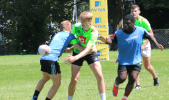 3:10
3:10
QBE - Support Line Breaks & Offloads
Support Line Breaks & Offloads
Maul and Ruck - Maul Gain Lines
With the maul, the gain line is fluid and the defence can be forced onto the back foot
With the ruck, the gain line is static and the defence are often set and on the front foot
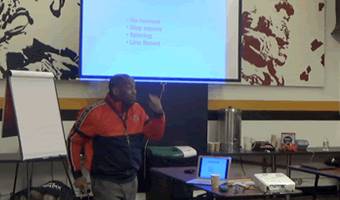 0:54
0:54
Principles of Defence - Line Speed
Ex Harlequins coach Collin Osborne explains his fourth defensive principle - Line Speed.
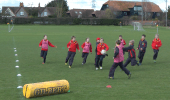 1:58
1:58
Colour Touch
In this game, defenders in coloured bibs are called back to touch their try line, creating space and opportunities for the attack to exploit.
QBE - Support Line Breaks
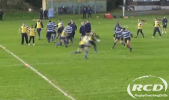 0:46
0:46
3 v 2 and then another defender
Develop decision-making skills in attack. 3 attackers must beat 2 defenders, before facing a third immediately after.
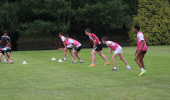 1:28
1:28
Quins - Defence Spacing & Line Speed
Tony Dirpose from Harlequins delivers a unit defence exercise on spacing and line speed
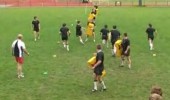 0:12
0:12
Draw the defender and support in channel
The key to creating space is to move a defender away from the space, this drill allows the ball carrier to create the space and the support runner to attack the space
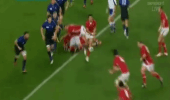 0:30
0:30
Men's - Patterns of play 1
Three phases of play with accurate passing and quick ball from each breakdown creates the opportunity for the scrum half to run through and score
Key factors : Present a target with your hands - Pass the ball laterally - Run straight / inside shoulder of the defender
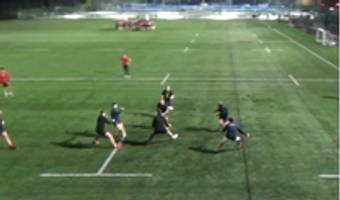 1:28
1:28
Attack vs Defence Continuous Drill 4V2
The attackers work to beat the defence, setting up a 'tip' (running a hard line) and 'pull back' option. They should read the defensive movements and make a decision to hit the tip option or pull out the back.
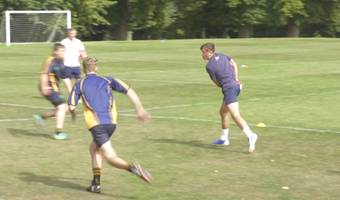 3:23
3:23
Attacking Shape - 4v1v1v1
This is the start of a series of progressions that takes you through how to set up your attacking shape through multiple lines of defence.
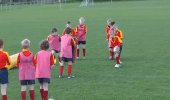 1:49
1:49
2 v 1 Passing
Adding a live defender helps to encourage players to hold their depth in support, so a good pass can be completed.
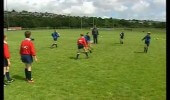 0:15
0:15
Introducing live defenders for 2 v 1
Developing passing skills with more pressure and intensity
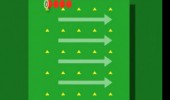 0:41
0:41
Learning to pass laterally in 4's
Developing our lateral passing skills. The coach can alter the width, depth and number of players
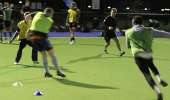 2:40
2:40
Two Channel Passing Exercise
Players work in 3s running around the corner and realigning to attack. Introduce defenders and the need to look up and communicate.
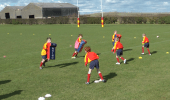 1:16
1:16
Head Position training in units
A progression in the tackle technique session is to have four defenders working at the same time. All attackers should go the same way (directed by the coach) and the defenders can communicate which way to go.
 2:06
2:06
L2 - Kicking Development
Skill Practice Description • The teams start with kicking netball i.e. the kicker cannot run and cannot be interfered with. • The player with the ball kicks to work the ball up field and a clean catch behind the goal line is 1 point • Other ways to score are by a drop goal awarding 3 points. • If a breakdown occurs the coach can award a free kick. • The ball carrier can choose to kick to a team mate or try for a target. • The targets can only be aimed at when the targets are in the other half of the pitch. • If the target is missed, possession goes to the other team. • Progression; the kickers must be ‘running’ when kicking the ball. • They must kick within 5 - 8 metres of running. They cannot just keep running with ball in hand. • Players can chip and catch for themselves. • This gives more opportunity for free kicks to be awarded through breakdown in play. • Allow players to discover personal techniques of kicking with both right and left foot. Punt, • Grubber etc. • Discourage throwing the ball up and develop the drop. • Identify those with consistently low outcome percentages and address the relevant technical factors
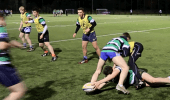 5:13
5:13
Improving support play
Decision making is a tricky skill to coach. Danny Wild the Leeds coach uses conditioned games with breakout technical sessions to improve this process as well as working on some groundwork skills
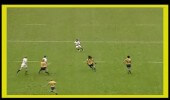
Running skills game footage the sidestep 2
Watching core skills in action

Running skills the sidestep 1

Running Skills in a game
Watch the skills in action
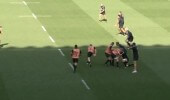 0:50
0:50
Attacking options from line outs
Developing continuity and understanding of support

